Writing And Language Test 35 Minutes 44 Questions Answers
Imagine waking up at midnight to the blaring sound of your fire alarm beeping loudly. The siren is blasting through the house warning you to leave. You leap from your bed and start towards the door, but before you get there your foot slips on a stack of books sitting across from the bed, and you fall. It takes you a few seconds to regain your footing and get out of the room.

Lucky for you, in this hypothetical scenario, there was no fire. It was just a false alarm. If this happened, though, you would work towards a better knowledge of the layout of your room, in case there was actually a fire next time.
This hypothetical situation is a lot like studying for the SAT® Writing and Language test. The better you know the layout, the better you will do on the test. If you have a good grasp of the rules of grammar, punctuation, and rhetoric, you will be more successful than if you don't understand the rules that govern written English.
This guide exists to prepare you for the treacherous terrain of the SAT® Writing and Language test and help answer the question of "How to get a perfect score on SAT® Writing and Language"? Keep reading to get an in-depth overview of the test and key components that you will need to master to score a perfect 800.
What do they Test?
The SAT® Language section is designed to test two areas of English Language skills. The first area is Usage and Mechanics, which tests grammar, syntax, punctuation, and proper use. The second area focuses on Writing Strategy, which tests expression, command of evidence, and editing.
If you can't already tell – one section of the test is going to be easier to study for than the other. Usage and Mechanics is a set of rules that you can learn. Those rules are laid out in a later section, but they will take some amount of memorization and practice to familiarize yourself with how they work.
Writing Strategy will be a more difficult section to practice. It requires you to understand more abstract ideas like how the topic of a passage is best expressed through organization or structure. Understanding the distinctive features that make the organization effective, or the reasoning behind those features, is much more complicated than just memorizing a set of rules.
Even though Writing Strategy might push you further, there are still strategies that you can practice to ensure you maximize your point totals. Sometimes it doesn't matter so much that you know the right answer on the test, as long as you can determine the wrong answers. We will keep that in mind as we talk about the structure of the test.
Test Structure
Knowing what is on the test is important, but you must also keep in mind the overall structure of the test. It, like the rest of the SAT®, is set with a specific time limit. That limit will determine how you answer questions and will color your approach to the questions.
The test has 44 multiple choice questions to be answered over the course of 35 minutes. There will be four passages with 11 questions each. The math works out to mean that you have about 47 seconds for each question, and that isn't even budgeting for reading the passages! If you want a perfect score on the new SAT® Verbal, you will need to get the most out of your time.
There are four passages with 11 sections each. The passages come from four different topics:
- Careers passages: The passage will present information and a debate within a career field like business, education, or medicine.
- Social Science passages: These passages will focus on a topic or phenomena from a field within social sciences like sociology, history, or psychology.
- Science passages: These passages will focus on topics and research within scientific fields like biology, chemistry, or physics.
- Humanities passages: These passages will explore the works or a particular era, author/artist, or genre of work. It could cover prose, poetry, dance, music, or art.
The writing and language section will break down to be roughly 24 questions on the writing strategies, with the other 20 focused on the grammar and usage. The breakdown between the two means that the test is almost evenly distributed between the two.
You might find, during your studying, that you are struggling to understand how to answer a particular type of question. Understanding the differences between the writing strategy and usage and mechanics sections is key to identifying weaknesses for correction.
The test is relatively straightforward in its structure. If you get all of the points, your raw score will then be scaled down to a 10-40 scale. Let's talk about why getting an 800 on the new verbal section is important.
The Value of 800
Earning an 800 may seem impossible, but don't be fooled. You can earn an 800. Thousands of students have done it before, and thousands of students will score 800 on their verbal sections in the future. The goal is to help you become one of those students.
For many students getting an 800 seems "extra", and you might be thinking, "I don't know if I will need an 800". Most students don't have what it takes to get an 800 on the verbal section, and an 800 isn't necessary to achieve their goals. The average SAT® score is 500, and most schools do not look for students who score 800 because those students don't apply. As a result, many students don't worry about scoring 800.
You are different. You aren't looking to get into any school. You are here, reading this article, which means that you are seeking to become excellent. The reality is that an 800 isn't just useful, but necessary.
Depending on your goals, there is a very real possibility that an 800 on the verbal portion of the SAT® is what you need to gain admission to the college of your choice.
For many of the top universities, a perfect SAT® score is competitive. Yale University, one of the top three in the world, is an excellent example of the competition that the SAT® creates.
At Yale the average SAT® Verbal score of admitted students is 760, the 25th percentile is 710, and the 75th percentile is 800.
What does this mean?
Most students at Yale score around 760 on the SAT®, but you don't want to be an average applicant. An 800 will set you apart. It will place you in the top 25 percent of students that are applying to the school.
Scoring an 800 is not only possible, but for many students intending to attend a top ten school, it is necessary. The breakdown of scores at Yale is similar to other top ten schools. When you apply to these schools, an 800 on the SAT® can show that you are a cut above, and help make up for weaknesses in your application.
The Challenge of Perfection
To earn an 800, you must score a 44 raw score on the Writing and Language section. A 44 raw score means that you must get every single question right. Take a look at the chart for how the raw scores on the test translate to scaled scores:
| Raw Score (# of correct answers) | Reading Test Score | Writing and Language Test Score |
| 38 | 32 | 34 |
| 39 | 32 | 35 |
| 40 | 33 | 36 |
| 41 | 33 | 37 |
| 42 | 34 | 38 |
| 43 | 35 | 39 |
| 44 | 35 | 40 |
| 45 | 36 | |
| 46 | 37 | |
| 47 | 37 | |
| 48 | 38 | |
| 49 | 38 | |
| 50 | 39 | |
| 51 | 40 | |
| 52 | 40 |
Notice that if you miss a single question, you will drop to a 39 scaled score. The scoring system leaves no room for error.
Note: Let's talk briefly about how the scaled to final score conversion works. You'll notice that we included the reading raw -> scale conversion on the chart. That is because the SAT® Verbal score is made up of a combination of the Reading and Writing and Language sections. This is new to the SAT® system and just came into effect in March of 2016.
The two tests now combine to form an overall verbal score which is half of the overall 1600 you can earn on the SAT®. The two raw scores will convert to a 10-40 and then the scaled numbers are added for a possible 20-80 total. The 20-80 is then multiplied by 10 to give you the 200-800 you can receive on the Verbal Section.
Getting a perfect score on the writing and language section becomes more important now because unlike the old SAT® a lower score on Writing and Language can hurt your entire SAT® Verbal score.
The test is unforgiving. There is no place for a mistake. So, how can people get an 800 when there is no forgiveness on the test? An 800 is possible because each question has only one right answer.
The Right Answer
Every question has only one correct answer. Every question has three incorrect answers.
Any question that seems like it has two possible answers doesn't, so don't be tricked. Realizing that there is only one right answer to every question allows you to overcome that trap.
We've been taught, in our English classes, that most questions have many valid answers. The texts that we read in English classes are often complicated, dealing with topics like inequality or coming of age. When writing an essay or participating in discussions in English, class teachers don't dismiss ideas as wrong.
In those classes, we often look for the question that is the most right, because no single answer can apply in all situations. That is not how the SAT® works.
The design of the SAT® acts as an equalizer so that any student can do well. Therefore, the answers are not subjective, and the questions all have a single correct response.
The key to scoring an 800 on the SAT® Writing and Language section is to find the right answer for every question. Let's go over a few strategies that can help when finding the right answer.
"How to Get a Perfect Score on SAT® Writing and Language" in Five Strategies

Strategy 1: Memorize the Usage and Mechanics Rules
The rules for usage and mechanics make up half of the SAT® Writing and Language section. The best way to study for Usage and Mechanics is to examine all parts of grammar.
Grasping the concepts contained within the subject of usage and mechanics can be difficult for many students. It's hard for the same reason that students struggle with math. Despite being a part of English, grammar rules, and functions actually, share many similar concepts to math.
The rules are often complex. Depending on the particular mechanic or usage, there could be anywhere from 3 to 10+ rules associated with the specific part of grammar.
Consider commas. Commas are probably the most used punctuation after periods. However, if you asked around, you would find that most people are hazy on the rules of commas. Commas come with a myriad of uses and standards – below is a short list of the possible uses and standards associated with commas:
- Use commas between independent clauses when used with coordinating conjunctions.
- Use commas after introductory phrases or words.
- Use two commas in the middle of a sentence to indicate that there is extra information inside.
- Commas shouldn't surround essential information.
- Use commas between words in a list or series.
- Use commas between two or more adjectives assigned to a noun
- Use commas to separate a phrase at the end of the sentence that references other information in the sentence.
- Use commas between places, dates, addresses, and titles.
- Use a comma in a dialogue between the prose and the speech.
- Use commas to prevent confusion.
That is ten rules. Ten. That is crazy. There are so many grammar rules that exist, most likely you don't know them all, but you need to know them for the SAT® Writing and Language. That means you will need to memorize the rules for each part of usage and mechanics. Before we get into ways you can remember the rules, let's review the concepts covered for usage and mechanics on the SAT® Writing and Language.
The parts of usage and mechanics break down like this:
- Punctuation:
- Commas
- Periods
- Colons
- Semicolons
- Dashes
- Apostrophes
- Agreement:
- Pronoun Number Agreement
- Subject/Verb Agreement
- Idioms and Homophone Usage:
- (Examples: affect/effect, either… or, to/two/too)
- Parallel Construction
- Comparison/Description
- Precision
- Sentence Fragments and Run-on Sentences
- Pronouns:
- Pronoun Choice
- Pronoun Case
- Verb Form:
- Tense
- Conjugation
- Modifiers
It seems like a lot, but don't let it overwhelm you. You already know some of the rules and concepts, and you have time to learn the others. Even if you only have two weeks before your test, you can drill and practice to memorize in many ways that will help you max out your scores.
The first step, before you begin memorizing, is to ascertain your weakness in usage and mechanics. You can find a test to identify your weaknesses here.
Once you know your weaknesses there are a few ways you can study for the usage and mechanics questions:
- Write Down the Grammar Rules on Flashcards: You can find the grammar rules here. On one side of a flashcard you will write down the particular usage or mechanic (like a comma) and a sentence that shows the rule used. On the other side of the flashcard, you write the rule. You will need to go through the flashcards by looking at the examples and reciting the rule to yourself.
- Work on Correction Worksheets: Download some copies of correction worksheets here or drill on Khan academy. Memorizing the rules is useful, but learning through correcting errors will also provide the opportunity to grow. Correcting improper usage and mechanics may be difficult, but it will give you practice that mirrors the test.
- Identify the Grammar Rules You See in Life: One simple solution to learning the rules of grammar is to look for them in the texts you are already reading. This type of practice is the most accessible. Despite the ease of access, it can be difficult to train yourself to notice grammar in the things you read every day. It will require careful observation and consistent reminders to yourself.
Those three strategies should help you keep on top of the grammar section of the SAT® Writing and Language test.
For more on "how to get a perfect score on SAT® Writing and Language" check out our next strategy that focuses on writing strategies.
Strategy 2: Begin to Notice Writing Strategies
Writing Strategies are the second set of skills tested on the SAT® Writing and Language section. The key to maxing out your score on the strategy section is to notice it in your everyday life. First, you need to understand the exam:
Writing Strategies tests a broad range of reading and writing skills. The section is officials testing the "expression of ideas" which covers the style, organization, and the effective use of language within texts.
When broken down into discreet skills, the Strategy section on the exam covers six broad categories:
- Tone: The attitude of the author on the subject of the piece.
- Cohesion: The coherence of paragraphs, sentences, and phrases
- Purpose: Understand why a text exists
- Formality: Determine the style of the text
- Congruence: Determine if a sentence fits
- Support: Examining evidence for inferences and claims.
Writing Strategy is going to be harder to beat than grammar. Grammar has a set of clear rules to memorize. Strategy, while it does have some objective and distinctive traits, usually relies more on inferences and experience to understand.
Some parts, like tone, are typically easy for students to identify. If you know words to describe the attitude, you match a word to the feeling portrayed by the author.
Others, like cohesion or congruence, require that you understand more of the nuance of writing. That only comes with focused reading and practice. To prepare for the SAT® Writing and Language, you will need to read texts (assigned or for pleasure) and focus on identifying where each of the tested parts of Strategy come into play.
Some readings that will show the distinct parts of Strategy are speeches and essays. If you have the chance, read some of those texts, and identify how the author uses each of the different parts of rhetoric.
You can work on some of the SAT® Writing and Language practice questions we have on the Albert.io website.
The key to strategy two is consistently analyzing texts to find those strategies that authors use.
Strategy 3: Practice for Perfection

Part of any winning strategy is practice. We practice for almost every activity. We spend endless hours shooting free throws or playing a particular measure from a piano concerto attempting to make it perfect. The old saying is "practice makes perfect" for a reason. It's true.
If you want to know "how to get a perfect score on SAT® Writing and Language", the first part is to realize that it means you will need to practice until you are perfect. It means long hours of commitment to studying and reading to improve your skills.
As a culture, we don't believe practice can help you with a test. We like to treat tests like an either, or situation: either you know the material, or you don't. That isn't true. You can practice for a test. You can improve your skills and knowledge through repetition and practice.
When you practice for the SAT® Writing and Language section, you should use the materials and tools provided in strategies 1 and 2. Using those strategies by themselves will not be enough. You must commit your time and energy to the practice.
Time
When you commit your time, it means you are setting aside those precious hours every week. You are attempting to earn a perfect score on the SAT® Writing and Language section. You will need to study approximately 40 hours in total to raise your scores from a 650 to 800.
40 hours divided over five weeks works out to 8 hours a week. That is a massive commitment, but this test is a huge part of your college admissions package. You have to devote the time necessary to get a perfect score.
When you set time aside to study, you must study fruitfully. Study time is easily wasted. When you study and practice, make sure you unplug: turn off your cell phone, don't listen to distracting music, shut down the T.V., and log out of your social media. If you spend just one hour a day fully focused on beating the SAT® Writing and Language, you will be one step closer to scoring 800.
Energy
Along with your time, you will need to commit energy to practice. That means full focus every time you sit down to work. Many students fail to practice because they don't focus their energy on the test. It is easy to be distracted or to fail to try your hardest when you know that the exam won't count. That isn't useful. You can't go into your practice situations half-heartedly.
When you take your practice tests, treat them as if they are the actual SAT®. Give yourself the right amount of time for the test, and put in the energy necessary to finish in that time-frame. If you don't put the energy of a real testing situation into your practice, you will never reach your full potential.
Finding Real Study Materials
Practice is only useful if it mirrors the test. You will want your practice materials to be as close to the test as possible. SAT® just redesigned the Writing and Language Section, so they are difficult to find. So difficult that there are no released tests to use. So the next best thing can be found here:
- SAT® Official Writing and Language Practice Questions
- CRACKSAT® Practice Tests
Those tests will be your best shot at finding out accurate scores on the SAT®. They should be used as benchmarks to gauge your progress. You should examine the amount of time you have left until the test, and space the tests out evenly.
The SAT® official practice questions should be something you complete to gauge your skills. Then you can drill the CrackSAT® tests as benchmarks to chart your progress.
Those practice tests are not going to make up the bulk of your study materials. You will need to use other training materials to improve your skills in between the tests. Some excellent materials for the test are on the Albert.io website. You should also check out practice books or articles online for free.
Regardless of the materials you use to drill the skills you will want to pick materials that are similar to the test. Read reviews before you purchase any books, and find websites that are highly rated by online communities.
Just Keep Practicing
Above all, keep practicing. Whatever schedule you set for yourself, keep to it. Whatever way you decide to practice, use it. There is little gained by sitting idle and waiting for the test to arrive. If you want to score 800, you will need to practice the test to perfection.
Strategy 4: Plug the Leaks

A practice schedule is important, but all the practice in the world won't make any difference without focus. It is important that you learn where you have weaknesses, and compensate.
If you imagine your testing ability as a boat, every weakness you possess has the potential to spring a leak. Too many leaks and your boat will capsize. That is why you need to work on filling the holes. You must practice to correct and compensate for your weaknesses to have any chance at scoring 800.
Diagnosing your weaknesses isn't easy. It will require you to begin to think seriously about the way you process information. If you find that there is a particular skill you lack or fundamental knowledge you haven't learned, you can push to change before the test.
Ask the Right Questions
As you go through the officially released tests, you should keep track of the items that you didn't know for certain. Marking all of the items that were not a 100% certainty will allow you to go back and ascertain the reason why you were confused even if you get the question right by chance.
Knowing that you couldn't narrow down the correct answer is important because it should lead to some deep thinking. You should ask questions like:
- Why was this choice right?
- Why were the other choices incorrect?
- What about the choices I couldn't rule out confused me?
- Why did I think those wrong answers could be correct?
- What rule or reasoning exists to prove the right answer?
Asking these deeper thinking questions will help you to go further in figuring out your weaknesses and making changes before you take your next test. As you test, always go deeper with the questions you ask, stopping at "what is the right answer" will never be fruitful.
Determine the Explanation Yourself
Beyond the questioning strategy, you will want to stop reading the answer explanations for the questions you drill. Instead, seek to figure out and explain the choices yourself. Nearly every test and program provide detailed explanations for why certain a choice is correct and why other choices are not, don't read those until after you have already explained it yourself.
Part of the growth process is struggling with difficult concepts to come out stronger. Reading the explanations doesn't challenge you to learn, and it means less focus on understanding the reasoning behind the choices. If you take the time to explain why one choice is correct and the others are not, you will learn much more about the test's construction, and the specific skills tested.
So, don't read the explanations until after you have already explained the choices yourself. Then read the explanations provided to ensure that they give similar responses to the ones you created. The logic should be similar in each, and as your explanations get closer to the ones provided, you can keep track to see if your scores improve.
Common Weaknesses
Some weaknesses are common among students. Here are the top three to avoid.
1 – Misreading the Question
One of the easiest mistakes to correct is misinterpreting the question. Testing situations often put students under pressure, leading to simple mistakes.
When you read the question, pay attention to the vital details mentioned. Questions on the SAT® give away major clues to finding the correct response in the wording of the question.
You must read the questions thoroughly so that you don't miss any valuable information. Pay attention to those very specific words like not. Students overlook test items that use the word not, which can lead to mistakenly answering with the wrong choice. If it asks you to pick the option written incorrectly, you might accidentally select one of the three that is correct by mistake.
Always read the question closely to glean information.
2 – Over or Under Choice of "No Change."
One of the choices on many of the grammar questions is "no change" which means that the chosen sentence has no grammatical issues. Students have trouble figuring out when that is the correct choice.
Some students choose to air on the side of caution, rarely choosing the "no change" option. While it is a good idea to look for grammatical errors on the test continually, it is not a good idea to see them where they don't exist. "No change" will be the correct answer about 25% of the time, so that means you shouldn't avoid it.
The flip side of this problem is students find no errors too often. If you are reading quickly and not thinking clearly – you might fall susceptible to this mistake. It is easy to skim a sentence and not see the error, so always make sure you re-read before picking "no change".
3 – Too Many Commas
A comma splice is when you put a comma where it doesn't belong. The comma splice is a common error on the SAT® Writing and Language because students read the sentences out loud to determine the errors. When they read, the students pause more often than is dictated by the grammar. This reading habit leads to placing commas where they don't belong.
Take this sentence for example:
Lily walked up to the house and took a long, hard look into the darkness of the surrounding forest.
This sentence has far too many commas. If we remove the commas, the sentence still works:
Lily walked up to the house and took a long hard look in the darkness of the surrounding forest.
The best remedy is to learn the comma rules. Once you know them, you will be less tempted to insert unneeded commas.
On the test, if all else fails, you can use the next strategy to narrow down to the right answer.
Strategy 5: One Answer to Rule Them All
The key to strategy five is remembering that there is only one correct answer to each question. No matter the appeal of the other choices, there is an obvious or apparent error in those choices. If you can rule out the three wrong options, it will give you the ability to choose the right answer every time.
Here is a sample question from Albert.io. Let's find the issues present in three of the four choices:
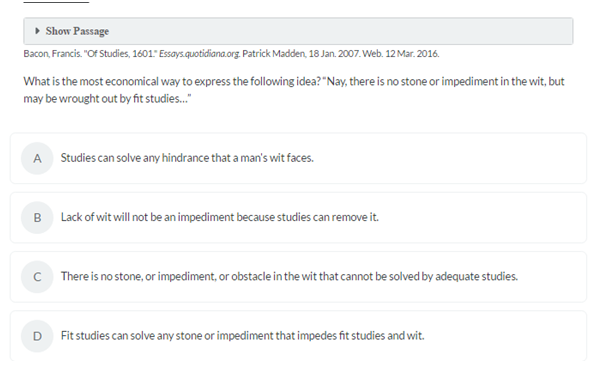
The question is asking the reader to find the most "economical" way to restate the point from the passage. This will require the reader to understand the passage and find the best way to express the ideas in the sentence. Let's examine the answer choices and determine which is correct.
Answer A – Correct Answer
Answer A is correct. The choice provides the shortest and most straightforward way to rephrase the sentence. The shortness of the answer choice is what accounts for the "economical" in the question.
Answer B – Convoluted Phrasing
Choice B is incorrect. The phrasing of this answer choice is confusing – which is the opposite of economical. Therefore it would not fit the criteria put forth by the question.
Answer C – Additional Rhetoric
Choice C is incorrect. Although it also retranslates the original phrase correctly, it adds in unnecessary elements. The use of parallel structure at the beginning of the sentence makes the phrase much more complicated than it needs to be, and the length of the sentence rules it out from being "economical" as the question requires.
Answer D – Repetition and Confusing Phrasing
Choice D is incorrect. It is also the easiest choice to rule out. It repeats its words multiple times, and it is so confusing that it doesn't say much at all.
Narrow it down
When you work through every question, you need to work on narrowing down the possible choices. Every question has one correct answer. You are looking for what is wrong with the other three choices as much as you are looking for what is right about the correct choice.
Bonus Strategy: Bubbling for Time
One last strategy for the test revolves around filling in the answer bubbles. The traditional way to bubble a test is very time-consuming. Students will move back and forth between the test booklet and answer sheet after every item.
The physical act of moving, first your eyes and then your hand, from the test booklet to the answer sheet takes a lot of available time. If it takes you 3 seconds to move from the test booklet to the answer sheet and bubble in the answer, and you do that for 44 questions, it will take you a total of two minutes and twelve seconds just for bubbling.
You will need all the time you can get on the exam. To save time on bubbling the best advice is to change your strategy. Instead of moving back and forth between the booklet and the test, only mark the correct answers on the test booklet. After about ten answers you should bubble in on the answer sheet. If you memorize a series of solutions like ABDCBBADCA you can save yourself time in the way that you bubble and cut down on making mistakes.
Find out what type of bubbling strategy works best for you and go with it. The time you save in bubbling the best way will be invaluable towards getting a perfect score on the SAT® Writing and Language.
Go and Get a Perfect Score
There are the five strategies to help you get a perfect score on the SAT® Writing and Language. If you work hard on each of these strategies, implementing them in your daily study and practice, you will have an excellent shot at getting the 800.
Review the tools often, come back to this guide any time you need a refresher. Make the adjustments necessary, and keep focused on your goals.
Remember to check out the Albert.io website for more blog posts and study help. As promised, there is a short guide to scoring an eight on the SAT® Essay below.
SAT® Essay
The SAT® Essay section is an optional section of the test. The top colleges, the same ones that care about your 800 in Writing and Language, will look for a score on the SAT® Essay. Opting for the writing exam adds 50 minutes onto your testing time, so be prepared for a longer test.
Two readers give a raw score of 1-4 for three separate categories. The two raw scores add together for each category to give you a scaled score. If one reader scores the essay at 3 and another at 4, you end up with a 7 for the section. You have 50 minutes to plan, write, and revise your essay. If you do it right, you can score an 8 for each section and make yourself that much more marketable to a top tier university.
Each section is graded on its rubric. The three sections that will be assessed are Reading, Writing, and Analysis.
Reading
The essay must show that you understood the passage provided in the prompt. That means you understood the important details, main idea, and argument presented. The essay must also show you read the text and can use it as evidence.
Here is the holistic rubric for reading from the SAT® website:
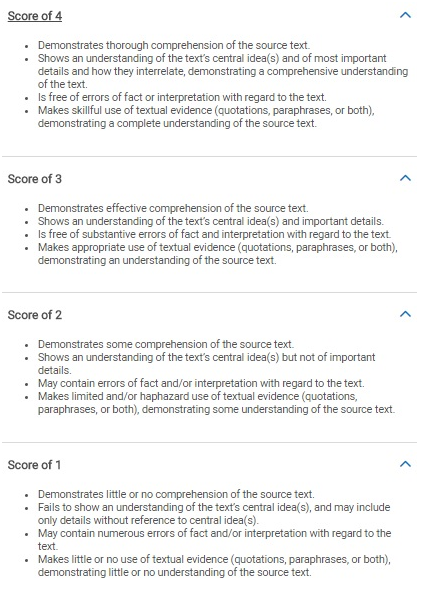
Analysis
The essay needs to show that you understand how arguments are constructed by:
- Examining the use of evidence, reasoning, and persuasion
- Creating a claim and supporting it with evidence of the text
The rubric from the SAT® Website:
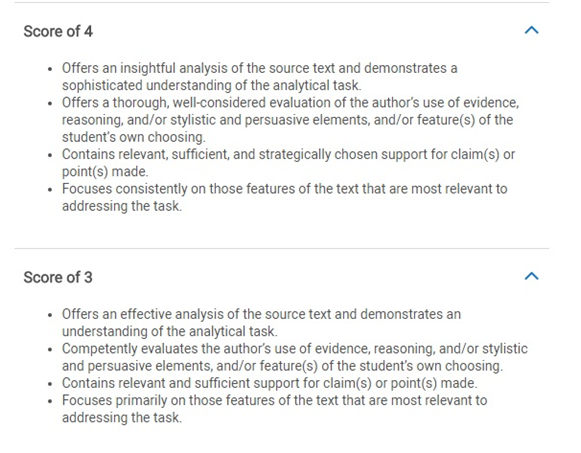
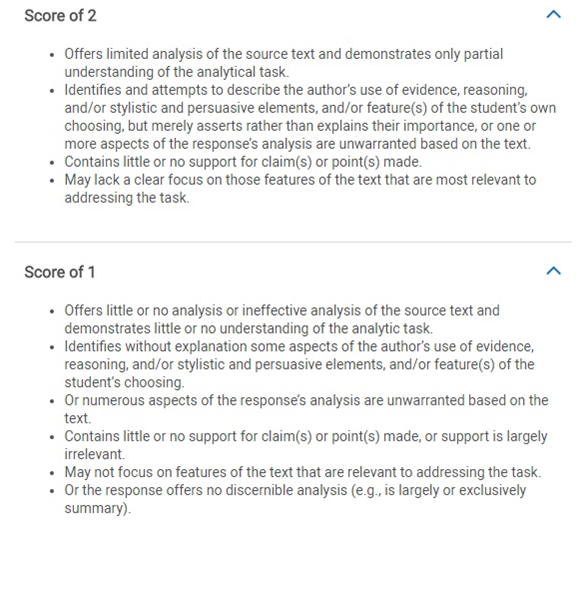
Writing
The essay needs to be well written. The essay must be focused, organized, and utilize the writing strategies that are common to standard written English.
The rubric for the writing portion of the essay from the SAT® website:
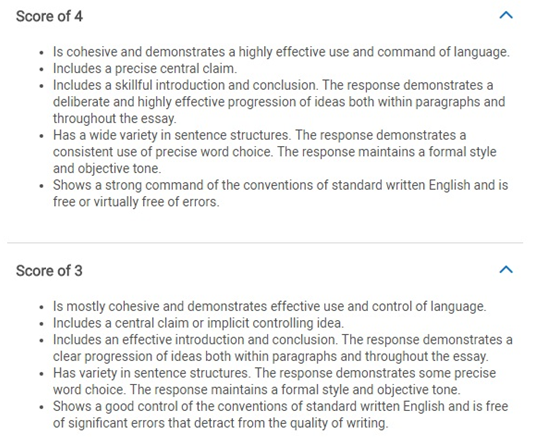
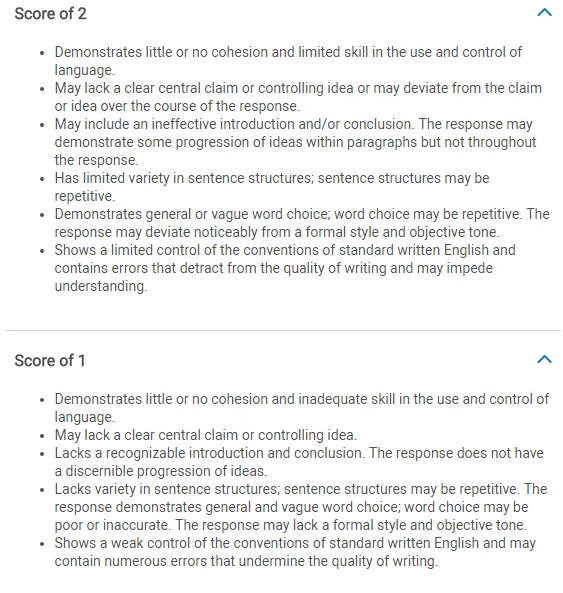
The essay presents a prompt and some relevant background information. The SAT® will require you to read an excerpt from a larger work. The excerpt will display an opinion, and the prompt will ask you to analyze the opinion finding the structure of the argument and explaining the most relevant or important parts.
An example of an SAT® Essay prompt shows the required parts:
Prompt
As you read the passage below, consider how Paul Bogard uses
- evidence, such as facts or examples, to support claims.
- reasoning to develop ideas and to connect claims and evidence.
- stylistic or persuasive elements, such as word choice or appeals to emotion, to add power to the ideas expressed.


Instructions:
Write an essay in which you explain how Paul Bogard builds an argument to persuade his audience that natural darkness should be preserved. In your essay, analyze how Bogard uses one or more of the features in the directions that precede the passage (or features of your own choice) to strengthen the logic and persuasiveness of his argument. Be sure that your analysis focuses on the most relevant features of the passage.
Your essay should not explain whether you agree with Bogard's claims, but rather explain how Bogard builds an argument to persuade his audience.
As you can see, the prompt is complicated. The essay asks you not to create your argument, but instead to analyze the argument put forth by the author. This and other essay prompts, as well as sample essays, can be found here.
This essay will be time-consuming, and it will be useful to practice your writing skills. Let's talk about a few strategies that can help you get the best score possible on the test.
Strategy 1: Make a Plan
You won't be able to anticipate the subject of the essay on the SAT® Essay section, but you can still work on the plan ahead for the exam. Along with the official practice prompts found on the SAT® website, the internet is full of prompts to analyze the argument of an article. The best way to prepare for the exam is to use those prompts to plan out essays.
You don't have to write the essays. Instead, work on your planning abilities. Many students fail to do their best on the exam because they are not ready for the rigors of writing a long and complicated essay. The best tool you have, regardless of the topic or requirement, is the ability to outline a high-quality essay quickly.
The time spent drafting shouldn't be more than 2 minutes, but the power of having a well thought out essay cannot be overstated. You should practice outlining on at least one essay a day for the three weeks leading up to your test. The act of planning will become second nature with practice, and that can make up for ignorance of the passage or subject matter.
A good outline should look like this:
- Introductory paragraph
- Thesis Statement: How is the author building their argument? Are they using facts, persuasion, or narrative techniques?
- Argument Technique 1
- Evidence from the text of this technique
- Argument Technique 2
- Evidence from the text of this technique
- Argument Technique 3
- Evidence from the text of this technique
- Concluding paragraph
- Wrapping up the argumentative strength of the essay
You'll notice that the outline follows the standard five paragraph format. If you find that you have extra time, you can expand each of the reasons into a series of paragraphs using multiple pieces of evidence, but the time pressure may make that too difficult to complete.
You should find two analytical prompts per day, and work out an outline for each prompt. The prompt will not be complete without a short sentence that explains the focus of each paragraph. Instead of only writing "introductory paragraph" you would write a short sentence that explains what that section would cover.
Let's look at an example outline for the prompt above:
- Introduction: In this essay, the author argues that artificial light is not a benefit to society.
- Thesis: He uses anecdotal evidence, rhetorical questions, and evidence of wasted money to make his argument.
- Paragraph 1: The author uses anecdotes to make the audience imagine their experiences with darkness. He pushes people to remember the power and mystery that darkness can instill in a person and the beneficial qualities of the beauty of darkness.
- Evidence: The author explains how the beauty of darkness allowed him to experience the joys of the natural world at night, and how that provided a formative experience in his younger years.
- Paragraph 2: The author asks rhetorical questions to get the audience to think about what is lost when darkness is drowned out by light.
- Evidence: You could point out some rhetorical questions he uses, but in particular he talks about the painting of starry night and asks if it would be possible that it could be painted without darkness. Which shows the value of darkness to beauty and humanity.
- Paragraph 3: The author makes the factual claim that there is money wasted on the unused light every year. This claim is supported by evidence of increased light usage across the United States.
- Evidence: There is evidence in the text given by the author about the wasted use of electricity. This should be used in the essay to the point that out.
- Conclusion: Reassert the main point of the essay and describe what the author is doing to craft their argument.
That is a very detailed outline for the essay. Your outline shouldn't be as detailed as this one, but it should still include all of the parts. You should have a short sentence in each part so that you know what you're planning to write when you sit down to do the essay.
Work to make your essay as detailed as possible, and practice your planning. That way you can be clear in your writing, and won't get stuck trying to figure out what should be in the next paragraph.
Strategy 2: Be Nice to Your Reader
This strategy is essential to doing well. You must make your writing easy to read. There are three essential things that you can do to make it easy for your readers to understand your writing, and therefore grade your essay faster.
Think about it; your readers will have about three minutes to read your writing, and they are reading about 500 essays in the entire session. The easier you make it on them, the more they are going to like you. As objective as we want to believe the test is, essay grading is still subjective. If they like you because you make their job easy, they might be more likely to give you a four over a three if your essay falls somewhere in between.
Legibility
You need to make your writing legible. The better your hand writing, the less you cross out, and the better your grammar and spelling, the easier it will be to understand what you are saying. If your writing is messy, and the reader has been reading essays all day, you might end up getting a much lower score than you deserve.
It is very easy to write off an essay that is difficult to read than to give it more time and effort. You need to put in the effort to make it easy to read. So work on your legibility.
Five Paragraphs
You should follow the five-paragraph format for an argumentative essay. One of the reasons for following the format is that it is standard. Being standard means that it will make reading faster, and it can help a reader understand your points much more succinctly. Utilize the format and help your reader process.
Clear Thesis and Reasons
The last point is that you need to have a clearly established main point, all of your evidence should support that main point. If your main point and evidence work together, it will make your essay much easier to read. Work on establishing a clear connection between your thesis, reasoning, and evidence to gain some extra favor in the eyes of your reader.
Work Hard and Score High
So that is the guide for how to get a perfect score on SAT® Essay and How to get an eight on the SAT® Essay. Use these strategies to ensure that you do well on the test and get the perfect score that you deserve.
If you have any questions or any other study strategies, let us know in a comment below.
Looking for even more SAT® Writing tips? You may find this list of 125 SAT® tips helpful.
Looking SAT® practice?
You can find thousands of practice questions on Albert.io. Albert.io lets you customize your learning experience to target practice where you need the most help. We'll give you challenging practice questions to help you achieve mastery of the SAT®.
Start practicing here .
Are you a teacher or administrator interested in boosting SAT® student outcomes?
Learn more about our school licenses here.
Writing And Language Test 35 Minutes 44 Questions Answers
Source: https://www.albert.io/blog/how-to-get-a-perfect-score-on-the-sat-writing-and-language-test/
Posted by: karlsonopli1944.blogspot.com

0 Response to "Writing And Language Test 35 Minutes 44 Questions Answers"
Post a Comment